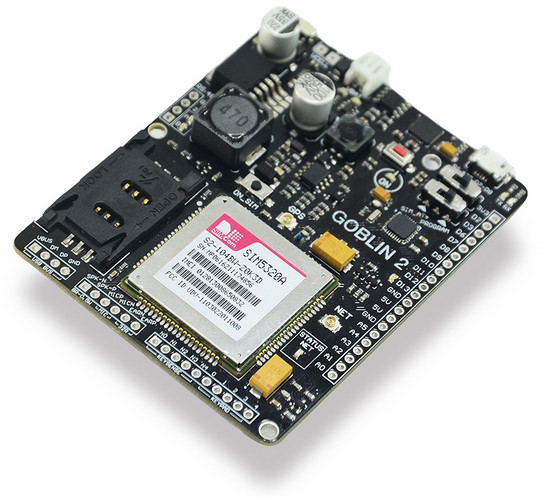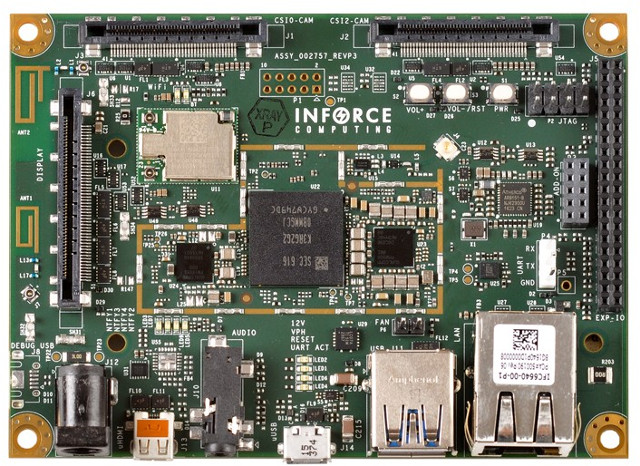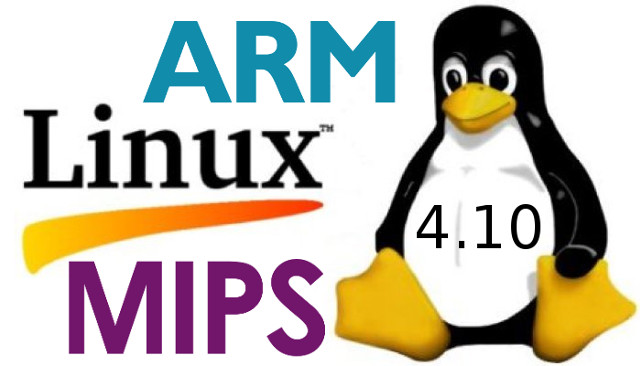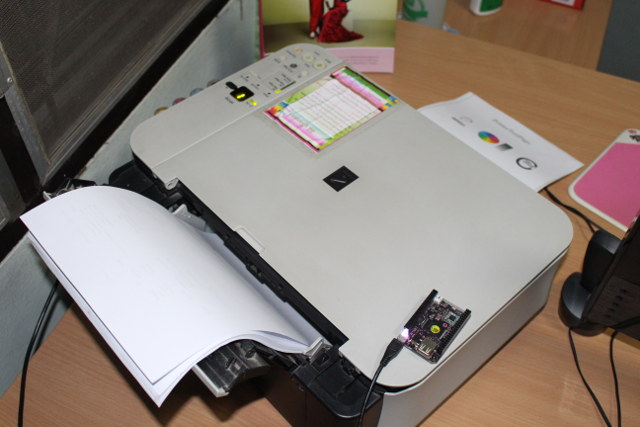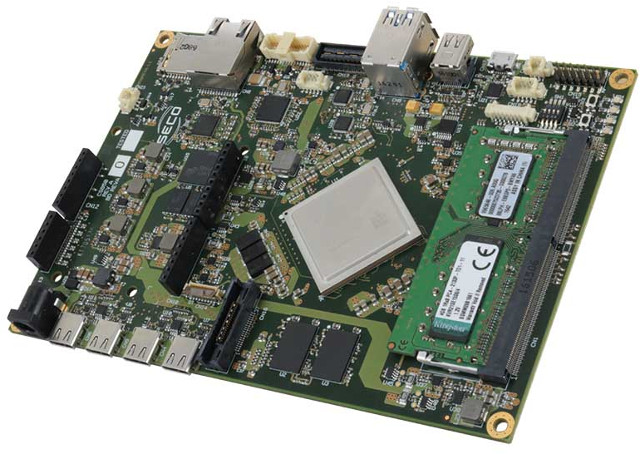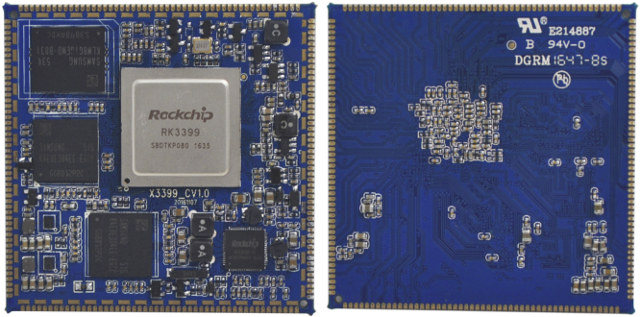Veracruz, Mexico based Verse Technology has recently launched Goblin 2, an Arduino compatible IoT development, based on Atmel/Microchip ATmega328P MCU, featuring a built-in SIM5320A 3G and GPS module, supporting RS-485 communication, and providing 3.3/5 and 24V power output. Goblin 2 board specifications: MCU – Microchip Atmel ATMega328P AVR MCU @ 16 MHz with 1KB EEPROM, 32kB Flash, 2kB SRAM Wireless connectivity via Simcom SIM5320A USB 2.0 module: Dual-Band UMTS/HSDPA 900/2100MHz Quad-Band GSM/GPRS/EDGE 850/900/1800/1900MHz 1x SIM card slot High accuracy 16 channel GPS Expansion I/Os 6x ADC input with 10 bits resolution 10x digital in/out including 5 PWM RS-485 protocol @ 10Mbps for up to 256 nodes on the bus Header to Keypad, microphone and speaker for SIM I/O Misc – 8 LEDs for power, battery, networking, RS485, UART, plus one user LED; Power switch, RS-485 /GPIO switch, program / SIM AT+ switch Power Supply – 5V via micro USB port, […]
Trenz Electronic TE0808 UltraSOM+ is a Xilinx Zynq Ultrascale+ ZU9EG System-on-Module
Xilinx Zynq Ultrascale+ ARM Cortex A53 + FPGA SoC have now started to show up in boards such as AXIOM Board based on Zynq Ultrascale+ ZU9EG. Price for the board has not been announced, and while a similar Xilinx development kit goes for close to $3,000, some people are expecting the board to sell for $400 to $600. Since the price of FPGA vary a lot from a few dollars to $40,000 for the top end chips, I decided to find pricing info about Xilinx Zynq Ultrascale+ MPSoCs which lead me to Trenz Electronic TE0808 system-on-module, which was unveiled in May last year, and I’ll cover in the second part of this post, after – hopefully quickly – describing Zynq Ultrascale+ family and nomenclature, and addressing the price “issue”. First, there are three sub-families within Zynq Ultrascale+ MPSoC portfolio: CG models with 2x Cortex A53, 2x Cortex R5, FPGA fabric […]
Qualcomm Snapdragon 820 SBCs: Inforce 6640, iWave iW-RainboW-G25S, and DragonBoard 820c
We’ve already covered Qualcomm Snapdragon 820 system-on-modules such as Intrinsyc Open-Q 820 and Inforce 6601, which can be used with baseboards that are suitable for development, but so far I had not seen a single board computer (SBC) powered by the processor optimized for mass production and suitable for integration into products. Bu this is about to change, as three Snapdragon 820 SBCs are now (or soon will be) available with Inforce Computing 6640, iWave iW-RainboW-G25S, and DragonBoard 820c. Inforce 6640 SBC Inforce Computing 6640 Single Board Computer specifications: SoC – Qualcomm Snapdragon 820 quad core Kryo processor with 2x cores @ up to 2.2GHz, 2x cores @ up to 1.6GHz, Adreno 530 GPU, Hexagon 680 DSP System Memory – 4GB LPDDR4 Storage – Up to 64GB UFS 2.0 flash, microSD slot Video Output / Display Interface – 2x 4-lane MIPI-DSI DPHY 1.2 , 1x HDMI 2.0 interface for touch […]
Linux 4.10 Release – Main Changes, ARM & MIPS Architectures
Linus Torvalds has just released Linux 4.10: So there it is, the final 4.10 release. It’s been quiet since rc8, but we did end up fixing several small issues, so the extra week was all good. On the whole, 4.10 didn’t end up as small as it initially looked. After the huge release that was 4.9, I expected things to be pretty quiet, but it ended up very much a fairly average release by modern kernel standards. So we have about 13,000 commits (not counting merges – that would be another 1200+ commits if you count those). The work is all over, obviously – the shortlog below is just the changes in the last week, since rc8. Go out and verify that it’s all good, and I’ll obviously start pulling stuff for 4.11 on Monday. Linus Linux 4.9 added Greybus staging support, improved security thanks to virtually mapped kernel stacks, […]
How to Use CHIP Board as a Linux Printer & Scanner Server
We have a Canon Pixma MP250 series multi-function USB printer connected to a Windows 10 laptop at home, and for several years, I had no problems printing from my Ubuntu computer to that printer. However, this setup recently stopped to work, and whatever I would do, printing would never start from my Ubuntu PC, even though the file was (allegedly) successfully transfered to the Windows 10 laptop connected to the printer. So I decided to setup my own printer server, as well as a scanner server since it’s a multi-function printer, using one of the boards from my collection. As I opened my cabinet, I wondered whether I would use an Orange Pi board, Raspberry Pi board, or Nano Pi board, but I needed WiFi since there’s no Ethernet in the office where the printer is located, and I found that Next Thing CHIP board was the ideal candidate as […]
RJCLIP Repairs Ethernet RJ45 Clips in Seconds
Ethernet cables are normally made of RJ45 (8P8C) connectors that come with a clip that helps keeping the cables in place. However, over the years, I’ve broken a few of those, and the solution is normally to cut the cable, and replacing the broken RJ45 connector with a new one using a crimping tool and a cable tester (or multimeter). This does the job put normally takes a few minutes of your time, or more if you’ve messed up the connection the first time. I’ve just come accross an alternative solution with RJCLIP. It’s just a small plastic bit that simply fits on top of the broken RJ45 connector, and acts like if something ever happens. It just take a few seconds to put it on. Youtube user Vince tried it out, and it does seem to work pretty well, but also has some caveats with some type of connectors, […]
EU funded AXIOM Board is Powered by Xilinx Zynq UltraScale+ FPGA + ARM SoC
Back in 2015, Xilinx unveiled Zynq Ultrascale+ MPSoC combining ARM Cortex A53 & Cortex R5 cores, a Mali-400MP2 GPU, and UltraScale FPGA, and the company recently launched ZCU102 Evaluation Kit based on the SoC, which sells for just under $3,000. But if you are based in the European Union, you’ll be glad to learn about 4 millions Euros of your taxes have been spent to design a board based on the same MPSoC family as part of the AXIOM project, which was developed in collaboration with European universities and companies with the “aim of researching new software/hardware architectures for Cyber-Physical Systems (CPS) to meet the expectations” in terms of computational power, energy efficiency, scalability through modularity, easy programmability, and leverage of the best existing standards at minimal costs. AXIOM (Agile, eXtensible, fast I/O Module) board’s key specifications: SoC – Xilinx Zynq Ultrascale+ ZU9EG MPSoC with four ARM Cortex A53 cores […]
9Tripod X3399 SoM and Development Board are Powered by Rockchip RK3399 Hexa Core Processor
9Tripod (九鼎创展) has just launched X3399 system-on-module powered by Rockchip RK3399 hexa-core Cortex A72/A53 processor, and as well as a corresponding development board for people wanted to get started quickly before designing their own baseboard. X3399 core board preliminary specifications: SoC – Rockchip RK3399 hexa-core big.LITTLE processor with two ARM Cortex A72 cores up to 2.0 GHz, four Cortex A53 cores, and a ARM Mali-T860 MP4 GPU with OpenGL 1.1 to 3.1 support, OpenVG1.1, OpenCL and DX 11 support System Memory – 2GB LPDDR3 (2x Samsung K4E8E304EE-EGCF) Storage – 8GB eMMC 5.0 flash (Samsung KLM8G1GEND-B031) IOs – 204-pin to be soldered on baseboard PMIC – Rockchip RK808-D Dimensions – 55×55 mm 9Tripod does have a forum in English, but the company provides most of the information in Chinese. I could not find details about Linux or Android images and source code, except a few mentions of Linux Qt, Ubuntu, and […]


